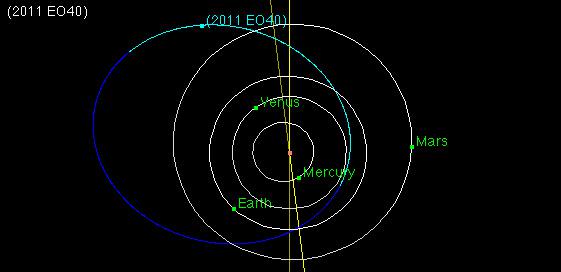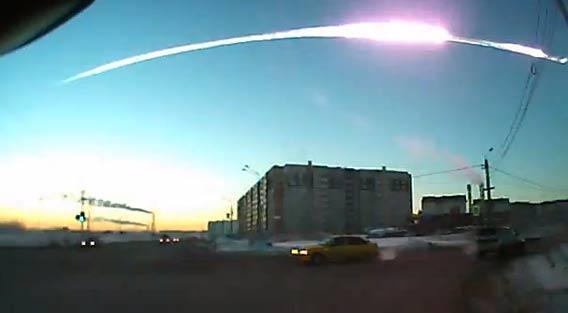In February 2013, Russians near the city of Chelyabinsk got a huge surprise in the early morning: A chunk of asteroid 17 meters (50+ feet) across came screaming into the atmosphere over their heads, leaving a trail of smoke kilometers long, and exploding with the force of a half-million tons of TNT.
Now commonly known as the Chelyabinsk meteor, it was the biggest impact we’ve seen since the famed Tunguska event of 1908. It showered down small bits of rock over a pretty big area (the rock itself coming in is called a meteoroid, the glowing phase of its travel through our air is the meteor, and the solid chunks that hit the ground are the meteorites).
Over the past few months there’s been some progress studying the meteorites. Samples are being investigated microscopically to determine their composition (preliminary results: it’s a standard chondrite, but more will be learned over time), for example.
And now a new result was just announced: The parent body of the meteoroid may be the asteroid 2011 EO40, an Earth-crossing rock a few hundred meters across. This conclusion isn’t 100 percent certain, but it’s reasonable. Here’s how it works.
First, what seems like a non sequitur: Russians have a lot of dashboard cams on their cars. Insurance fraud is rampant there, so dashboard cameras can be used as evidence in the courts. But that means a lot of other events are also captured, and within an hour of the Chelyabinsk event a lot of videos started popping up on the web. Because the location of the cars was known, and the position of the meteor as seen in the sky could be determined, the three-dimensional path of the incoming rock could be found.
This could then be back-tracked into space, giving the orbital characteristics of the meteoroid. It turns out it was on an elliptical orbit that crossed the Earth’s (as it had to in order to hit us). However, astronomers were only able to get a rough estimate of the exact orbit, because the observations weren’t precise enough.
So a pair of astronomers did something clever: they used what’s called a Monte Carlo technique to get the orbit. They took the orbital estimates and then ran thousands of computer simulations of the orbit, tweaking certain physical characteristics (like its distance from the Sun, the shape of the orbit, the tilt of the orbit, and so on) for every run. If this is done enough times a good statistical determination of the orbit can be found. They tested their software against a previously-known asteroid (2008 TC3, a small rock that hit over Africa in 2008) and it worked well, so they’re reasonably confident in their work.

Diagram by NASA/JPL
They then searched the asteroid databases to look for any matching space rocks, and found several. The best fit, though was to 2011 EO40. Mind you, this is not an exact match, but it does seem probable. They speculate that the parent asteroid may have split, perhaps due to an earlier close pass to a planet—many asteroids are not solid, but instead piles of rubble held together by their own weak gravity. The near-pass could have torn off a loose piece, sending it on its own orbit, and a later rendezvous with Earth.
Many asteroids in the solar system have similar orbits to each other, and we call these clusters families. We think each family comes from a single parent asteroid. In the case of the Chelyabinsk rock and asteroid 2011 EO40, family, those rocks pass near the Earth, Mars, and even Venus and the largest asteroid, Ceres. Over time, the gravity of these worlds changes the orbits of the smaller asteroids. Tracing the orbits back, the astronomers found the family must be less than about 20,000 - 40,000 years old. So whatever event split that asteroid (assuming that’s what happened) it occurred fairly recently.
I find this all rather amazing. We can learn so much about our solar system due to a lot of weird happenstance: A rash of frauds force a country to monitor their daily travel with cameras; a decent-sized chunk of rock happened to fall in the morning when lots of people were about, and of course the fact that pieces of the solar system happen to fall to the Earth in the first place. Also, the fact that we’ve been studying them for centuries, and have learned a substantial amount about how they behave.
I’ll note that right after the Chelyabinsk event, meteorite collectors converged on the area looking for fragments. Those chunks soon reached the marketplace, and my friend Richard Drumm was able to purchase a few from Galactic Stone and Ironworks, a licensed dealer. Richard then sent me one:

Photo by Phil Plait
That’s right, I have my very own piece of space rock from this event. Holding that asteroid sample in my hand makes the hair on the back of my neck stand up. What history does it have? What events and objects did it encounter over its 4+ billion year lifetime spent orbiting the Sun, before one sunny morning a blue-green planet swelled into view, blocking its path…?
Tip o’ the Whipple Shield to JenLucPiquant on Twitter.
